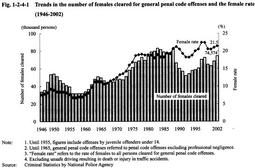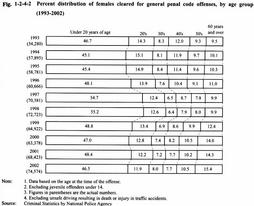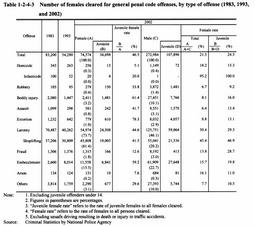| Previous Next Index Image Index Year Selection | |
|
|
1 Penal code offenses committed by females Fig. 1-2-4-1 shows the trends in the number of females cleared for general penal code offenses and the rate of females (female rate) to all persons cleared for general penal code offenses since 1946. The number of females cleared continued to rise while showing a wave pattern peaking in 1950, 1964, and 1983. After bottoming out in 1992 at 52,000 level, it started to rise gradually again, increasing by 6,151 from the previous year to 74,574 in 2002. The female rate, which showed an upward trend since 1946, surpassed the 20% in 1988, and it fluctuated around 20% since then. In 2002, the female rate increased by 0.5 points from the previous year to 21.5%. Since 1989, the number of females cleared for general penal code offenses per 100,000 females aged 14 or over (rate per population) has been between 100 and 130, marking 130.8 in 2002 (up 10:3 from the previous year) (see Appendix 1-1 ).
Fig. 1-2-4-1 Trends in the number of females cleared for general penal code offenses and the female rate(1946-2002) Fig. 1-2-4-2 shows the percent distribution of females cleared for general penal code offenses over the last 10 years, by age group. Juveniles have accounted for the largest share; juveniles were about half of those cleared and the rate of juveniles to all persons cleared (juvenile rate) was 46.5% in 2002. Among adults, the shares of those in their 20's to 50's have declined or remained flat whereas the share of those aged 60 or over has been on the rise.Fig. 1-2-4-2 Percent distribution of females cleared for general penal code offenses, by age group (1993-2002) Table 1-2-4-3 shows the number of females cleared for general penal code offenses in 2002, by type of offense, compared with the number in 1983 and 1993. In 2002, females cleared for larceny accounted for the majority at 73.7%, followed by embezzlement and bodily injury. More specifically, about 80% of those cleared for larceny committed shoplifting and most of those cleared for embezzlement committed misappropriation of lost property. The rate of females to all persons cleared (female rate) was high for larceny (30.4%), homicide (18.2%), arson (16.1%), and embezzlement (15.7%), and females accounted for about 95% of those cleared for infanticide in homicide.As mentioned above, the juvenile rate was high among females cleared for general penal code offenses. By type of offense, the juvenile rate was extremely high for extortion (78.3%), bodily injury (61.4%), and robbery (53.8%). Thus, the juvenile rate was remarkably high for female heinous and violent offenses. Table 1-2-4-3 Number of females cleared for general penal code offenses, by type of offense (1983, 1993, and 2002) |


